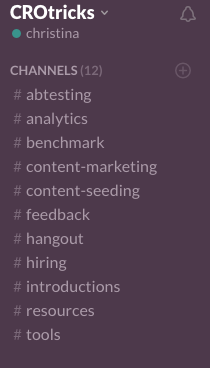One of the top questions we regularly receive relates to the Slack tool. With so few platforms for education realistically providing a social, community-based portal, complete with a full mobile solution, but also integrating important tools beyond simple SSO, some clever Chief Information Officers have looked to the business world. Enter Slack.
Keep in mind, Slack is a super useful tool and we actually use it here at Campus, for our internal communication. We use it to track progress, to communicate across teams, and to gain access to documentation, especially coming out of our Product Mangement tools and more.
This probably begs a question or two from you. If we were you, our first question would be, ‘Why don’t you use your own platform for that?’
The short answer is, “because we aren’t a college or university….we’re a business.” Slack is fantastic for its integrations with technology tools like Jira or Zapier. It’s powerful for its integration with G Suite, allowing managers to see what was written or sent to customers. And it’s great for setting up separate channels (workstreams) that can compartmentalize communication around the right context. It’s awesome at that stuff!
But, for a college or university, trying to connect students, faculty, staff, administrators, and potentially groups like alumni, prospects, and even parents…Slack likely isn’t the best tool for the job. When a school needs to fully integrate the LMS, the SIS, a CRM, as well as adding iCal and rss feeds, incorporating tools like Handshake or Slate into the mix, Slack starts to lose its flexibility. It’s like buying an extended cab truck with a family of 8. Those two little half-doors aren’t going to make life any easier as you try and squeeze way too many people into the cab, eventually needing to put a few back in the bed of the truck. Sorry…it’s time for a mini-van or a 9 passenger SUV.
{{cta(‘f3efec4f-e79e-4379-abbb-f689b57346fe’)}}
Starting with the “freemium” model (the incomplete, free version of the platform that will take up to ~8400 users) you obviously start to question whether the free version is an enterprise solution. Even a university of 5,000 FTE likely has 7500-9000 students, not to mention faculty and staff. Obviously any other considerations of adding prospective students or alumni is out of the question too. But, say you choose to only bring the efficiencies and connectedness to a portion of the students, faculty, and staff. Ok, let’s explore that.
With the driving needs of data and archiving in education, the 10k message search in Slack’s free version is tough. As well, with only 10 integrations possible, SSO isn’t possible for most of your institution’s tools. (More on academic tools in a moment.) But, once you move to the paid plan and get the full feature set, the $8-22 per person/per year price tag (depending on your ability to wheel and deal) will likely force most schools to use Slack for only a portion of their population, again missing out on retention and other gains via an enterprise experience.

Slack channels are based on people, not groupings that are contextually meaningful to a school. So, creating a channel for the Accounting department, while also creating a private area for Faculty Senate conversations, while also building a channel for all law students…those things are going to take a lot of time and patience as members will have to be added (and deleted) manually over and over again. Just Google Slack and Datatel or Banner (etc) and you’ll notice there is no integration there. So, automatically creating groups of people within the context of a college or university just won’t happen without a lot of programming.
At the same time, the resources (even beyond the LMS, SIS, etc) become an important component of college workflows for students, faculty, and staff. Slack won’t allow a user to personalize their menu with campus maps, won’t include a link to their campus account information making it a single click away, multiple calendars, or other important resources. Likewise, the addition of events, coupled with notifications and community around those events is not really a workflow Slack recognizes. So, as the school considers a personalized experience for stakeholders, Slack just doesn’t have that kind of flexibility. While they have hundreds of integration options, they are business-oriented, not higher education oriented.

As mentioned previously, cost is likely another concern. At Ucroo, our cost of Slack (per user) is quite manageable. But even if a school has only 1000 students, with 200 faculty, 200 administrators, 300 potential recruits, and 10,000 alumni, choices would have to be made regarding who does and who does not get an account. As soon as the school size jumps to 5,000 or 10,000, the solution is likely priced out of contention. So, (for example) pushing a hyper-connected experience to all prospective students (which would likely “wow” them into believing the school was extremely modern, if not advanced), but then removing that solution once they became students…is almost cruel. Needing to pick and choose due to price would make this hard for education.
{{cta(‘f3efec4f-e79e-4379-abbb-f689b57346fe’)}}
Finally, the savviest education technologists understand the importance of data as well as data security. An allegedly small number of people at Slack have access to the systems that store and process your data, but it’s unclear exactly how many Slack employees do, and who, exactly, those people are. If you have ever read through a standard, higher education technology contract, you know how meticulous and explicit data security must be. After all, education data represents the third most stolen data set by industry, after financial services and healthcare. But aside from security, while Slack can create some interesting analytics for a business, again it falls short for education. As more and more institutions are creating predictive and behavioral analytics, the addition of affective data per student (engagement, participation, liking, etc) is increasingly important. Slack simply does not create that kind of metric to correlate to existing measures of demographics, academics, etc.
At the end of the day, Slack is an awesome platform for sure, but it’s not really built for education. Sure, you could try to make it work, but our guess is that it will only work for super savvy, “power” users, whereas your ever-day student, faculty, or staff member will struggle to find what they need, when they need it. (Or, they will only use 10% of the tools, not realizing what it can really do.)
On the other hand, Campus is absolutely built for schools, but would not be a good resource for business. It’s organized to align with educational contexts and needs, seen in the 5 tenants of Community, Communication, Personalization, Integration, and Data. It’s also priced for education, not for-profit companies nor for Silicon Valley.
So yes, we agree with those of you who ask if Slack is a great tool. It is! But not really for a college or university wanting to create connectedness across the entire institution while putting the exact right tools, people, and support in front of the exact right people when it matters.
{{cta(‘f3efec4f-e79e-4379-abbb-f689b57346fe’)}}